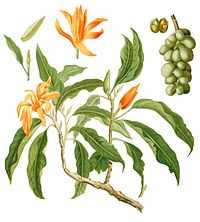Magnolia champaca
| Champak | |
|---|---|
 | |
| Scientific classification | |
| Kingdom: | Plantae |
| (unranked): | Angiosperms |
| (unranked): | Magnoliids |
| Order: | Magnoliales |
| Family: | Magnoliaceae |
| Genus: | Magnolia |
| Species: | M. champaca |
| Binomial name | |
| Magnolia champaca (L.) Baill. ex Pierre[1] | |
| Synonyms[2] | |
| |
Magnolia champaca, known in English as champak,[3] is a large evergreen tree, native to the Indomalaya ecozone (consisting of South Asia, Southeast Asia and some parts of China).[4] It is best known for its strongly fragrant yellow or white flowers. It is, however, primarily cultivated for its timber, and is also used in urban landscaping. Its aril-covered seeds are highly attractive to birds.[5]
Varieties
This species occurs in varying shades of cream to yellow-orange. In China, M. champaca var. pubinervia is documented.[6] Magnolia × alba is a hybrid cultivar of M. champaca. In Thailand, there has been some purported man-made hybrids with other magnolia species including Magnolia liliifera and Magnolia coco.
Etymology
The species epithet, champaca, comes from the Sanskrit word campaka (pronounced tʃaɱpaka).However, Champaka, and its literary forms Chanpakam (Cankam literature) and Chenpakam in Tamil are listed as words of Dravidian etymology.[7]
Vernacular names
Common names in other languages include champaca, champak; Sampige (ಸಂಪಿಗೆ) in Kannada. Sonchaaphaa (सोन चाफ़ा) in the Marathi language; Chenbakam/Chenpakam (செண்பகம்) in Tamil; Chenbagam in Malayalam; shornochampa (golden champa), স্বর্ণচাঁপা in Bengali; champa, cempaka, sampenga and sampangi in Telugu; cempaka in Malay; jeumpa in Acehnese and shamba. All other names above apply to Plumeria varieties as well, with the exception of Sonchaaphaa, which is used exclusively for this particular subvariety in Western India. Some half a dozen varieties of Plumeria together with Magnolia champaca (three varieties) and two varieties of Ylang Ylang are generically called Chaaphaa in Marathi,Manoranjitam in Tamil, though in some cases, a further descriptor is added: the red plumeria variety, for instance, is Dev Chaaphaa or God's Champa, and the two Ylang Ylang varieties each have a separate name as well.Malayalam :Panineer Champakam In Theravada Buddhism, champak is said to have used as the tree for achieved enlightenment, or Bodhi by seventeenth Lord Buddha called "Aththadassi - අත්ථදස්සි". The plant is known as සපු (Sapu) in Sinhala, and චම්පික (Champika) in Sanskrit.
Uses
Perfume
The flowers are used in Southeast Asia for several purposes. Especially in India, they are primarily used for worship at temples whether at home or out, and more generally worn in hair by girls and women as a means of beauty ornament as well as a natural perfume. Flowers are used to be floated in bowls of water to scent the room, as a fragrant decoration for bridal beds, and for garlands.
"Magnolia champaca however is more rare and has a strong perfume, and is not that commonly or plentifully used - for example in hair it is worn singly or as a small corsage but rarely as a whole garland, and for bridal beds it is most often jasmine and roses while for bowls of water to be placed around rooms usually other, more colourful for visual decoration and less strongly perfumed flowers are used."[8]
Many niche perfumers are now once again using Champaca Absolute as single note fragrances.
The scent similar to the scent of this plant is said to emit by a civet in Sri Lanka, Paradoxurus montanus. Because all the other civets are known to emit very unpleasant odours, this species is renowned to emit pleasant odour similar to this plant's scent.[9]
Cultivation
Magnolia champaca is cultivated and used as an ornamental tree in temperate climate gardens, such as in coastal California.
See also
References
- ↑ Fl. Forest. Cochinch. 1: t. 3 (1880). "WCSP (2013). World Checklist of Selected Plant Families. Facilitated by the Royal Botanic Gardens, Kew.". Retrieved July 17, 2013.
- ↑ "The Plant List: A Working List of All Plant Species".
- ↑ "CHAMPAK". Oxford English Dictionary (3rd ed.). Oxford University Press. September 2005.
- ↑ "Germplasm Resources Information Network_USDA".
- ↑ FRISCH, J.D. & FRISCH, C.D. - Aves Brasileiras e Plantas que as atraem, São Paulo, Dalgas Ecotec, 3rd. edition, 2005, ISBN 85-85015-07-1, page 374
- ↑ "Flora of China FOC Vol. 7 Page51,80".
- ↑ Dravidian Etymological Dictionary, entry number,2321
- ↑ Minter, S. "Fragrant Plants." in Prance, G. and M. Nesbitt. (2005). The Cultural History of Plants. London: Routledge. 242.This is great
- ↑ http://wizzley.com/sri-lankan-brown-palm-civets-paradoxurus-montanus-non-ringtails-of-sri-lanka/
Further reading
- Fernando, M. Thilina R., et al. "Identifying dormancy class and storage behaviour of champak (Magnolia champaca) seeds, an important tropical timber tree." Journal of the National Science Foundation of Sri Lanka 41.2 (2013): 141-146.
External links
| Wikimedia Commons has media related to Magnolia champaca. |